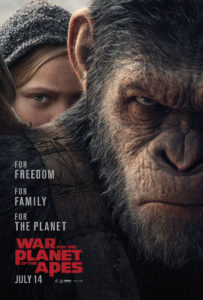
War for the Planet of the Apes
Director: Matt Reeves
Writer: Mark Bomback, Matt Reeves
Starring: Andy Serkis, Karin Konoval, Woody Harrelson
A review by Billy Seguire
 This is a war movie. An epic instalment in the saga of man-to-ape genesis, War for the Planet of the Apes takes its cues from films about Vietnam, WW2, the old west, and biblical allegory to form a commentary on war as a painful, dehumanising effort. Removed from its science-fiction origins, War for the Planet of the Apes succeeds as character drama, presenting our hero Caesar as a burned out and broken shell determinedly fighting to his end. You could make Caesar human in this script without losing a thing, but a familiarity with Planet of the Apes lore makes this film soar.
This is a war movie. An epic instalment in the saga of man-to-ape genesis, War for the Planet of the Apes takes its cues from films about Vietnam, WW2, the old west, and biblical allegory to form a commentary on war as a painful, dehumanising effort. Removed from its science-fiction origins, War for the Planet of the Apes succeeds as character drama, presenting our hero Caesar as a burned out and broken shell determinedly fighting to his end. You could make Caesar human in this script without losing a thing, but a familiarity with Planet of the Apes lore makes this film soar.
Caesar begins War for the Planet of the Apes as an ape past his prime, the noble ruler still leading the resistance of his tribe through a seemingly endless struggle. The community has been in a state of war for five years, with several of the gorillas having turned traitorous in the name of self-preservation. It’s a slap in the face to the “apes together strong” philosophy that’s bonded the apes together in the past, but makes each ape more individual for their ability to choose sides.
From the outset, War for the Planet of the Apes presents a more complex look at the character behind these apes. The motion capture technology that’s been so praised in past films is downright spectacular here, allowing for facial expressions with nuances that make the richer emotions play out with newfound realism. I never once found myself distracted from an actor’s performance. On that front, Andy Serkis in particular deserves recognition for his role. Caesar is now a fully vocal character, capable of nuanced speech and impassioned delivery, making his ominous silence in scenes of character-driven stoicism stand out. The inner conflict and sacrificial self-doubt makes the Caesar of War for the Planet of the Apes so different from the Caesar of previous films. Serkis hits every note perfectly, and the script gives him so much to do that this is arguably the strongest performance Serkis has given yet.
To push Caesar past his limits, both Cornelia and Blue Eyes are killed early on in the film, leaving a grief-stricken Caesar at war with his darker nature and haunted by the shadow of Koba, a representation of the potential cruelty and hatred Caesar holds within his grief. It’s a tried and true motivator that works in a film written primarily as a revenge flick, and while it’s been done before, relying on these tropes of old-school of filmmaking works to set the tone of the film right from the start. The “apes together strong” line, spoken repeatedly throughout the film, is now an ironic reminder of how much has changed with Caesar withdrawing into himself and striking it out on his own.
Suitably, in the face of a hardened Caesar, War for the Planet of the Apes leans hard on Maurice the Orangutan as the heart of the film. Always a standout character, it’s an absolute joy to see Maurice’s role increased so substantially as one of the three apes who accompanies Caesar on his journey of revenge. The trusted confidant, Maurice shines the most during the western-inspired scenes with the apes travelling on horseback. When he tells Caesar he’s following him to make sure he comes home, it hits harder knowing these two characters have supported one another for the last fifteen years. Similarly, Maurice’s instant connection with Nova, a mute girl whose father Caesar has killed only moments ago, hints at his sensitivity, and his inability to leave her alone demonstrates his staunch ethical code. Karin Konoval has consistently given Maurice the weight of an old soul, and that weight has never been so apparent as in this film.
Yet it’s the inescapability of war that dominates the narrative, forcing the apes down a darker path. There are unsettling parallels to real world events during sequences set within the concentration camp. These images are not untrodden ground in film by any means, but it’s still jarring to see the Planet of the Apes franchise take itself so consistently seriously, presenting apes as a racial minority unjustly persecuted by those that feel threatened by their existence and putting that in a historical context. The way the soldiers refer to their defected apes as “donkeys” is a painful delegitimization of their personhood, and the film mixes eras of wartime allegory seamlessly to put the apes through hell.
As the antagonist of the film, Woody Harrelson is intimidating. Taking cues from the demented leadership of Christopher Eccleston in 28 Days Later or the warlords of Mad Max, Harrelson’s Colonel lets sociopathic impulses drive his command. In truth, the actor hasn’t been this intimidating since Natural Born Killers, and as the Colonel, he presents a fitting final demonstration of inhumanity for humanity to go out on. Power is exuded by his stillness. The fact that his soldiers are named after Alpha & Omega, the underground cult of Beneath the Planet of the Apes, adds an extra layer of blind devotion to their cause. Their actions are undertaken substantially by fear, using their hatred of the apes justify arrogance in the face of the horrible atrocities they’re committing.
This is also the movie that found substantial comic relief in Steve Zahn as Bad Ape, a new character who counts as the first simian to display the ability for heightened intelligence and speech outside the original group of apes. There was laughter in the theatre during his scenes, and juxtaposed against scenes of violence and oppression, the humour was more than welcome. Earlier films in this franchise felt balanced, but War for the Planet of the Apes determinedly uses jokes to lighten the mood. While off-putting in concept, the comedy only serves to highlight the darker elements and is careful to understand what a thin line it walks.
As a long-time fan of both the old and new incarnations of the franchise, War for the Planet of the Apes succeeds in recreating the imagery of the original 1968 film. The crucifixion of Caesar on a St. Andrew’s Cross is disturbing in its context, but incredible when you remember the sun dried corpses Charlton Heston encountered upon arrival. The mutation of the virus that leads to humans losing the ability to speak is a main plot point in the film, and works as the natural next step in the evolution of the ape/human relationship. Even on a surface level, the varied visual design of these apes on horseback is beautiful, and as stunningly unique as snow on the fur of the apes. The change in geographic setting was a necessary step in making War for the Planet of the Apes stand out, and calls to mind the Empire Strikes Back battle scenes set on Hoth.
I am troubled by the lack of roles for women in the film. Nova is the most well-rounded female character, the mute girl taken in by the apes when her father is killed by Caesar. While present throughout a majority of the film, the fact that she’s mute limits her ability to fully participate in the story with her own agency. This at least has an in-story reason and leads to Nova’s own struggle with identity. But even outside of the human element, there was room for a more heavily female ape presence. Although briefly seen, Caesar’s daughter-in-law Lake demonstrates strength, courage, and loyalty. Seeing that explored more thoroughly in the context of the film would have been interesting. Comparing the relationship of Nova and Caesar to Laura and Wolverine in Logan, War for the Planet of the Apes equates femininity to represent a purity of innocence, and while women are present in minor ways throughout the film, the prime movers of the plot continue to be men.
Overall, however, I was enthralled by how far War for the Planet of the Apes pushed the franchise into new thematic depths, exceeding both the science-fiction family drama and post-apocalyptic political thriller the last two films turned out to be. The organic score created by Michael Giacchino emphasises how outside the rule of man we are in the emotional conclusion to this arc. By the end of the film, when biblical allegory takes full hold and the individual character Caesar gives way to the creation of a religious icon, it’s a moving experience. I didn’t feel these allegories were necessarily heavy-handed or distracting from the purpose of the film, but rather completely in line with the breadth of what the revived Planet of the Apes franchise is trying to explore.
The Verdict
See It. If you enjoyed the last two Planet of the Apes films, witness War for the Planet of the Apes as soon as you can to fully take in the impressive growth this franchise has undergone over the past six years. Both a showcase for motion-capture effects and a nuanced character piece, the film is epic in its scope. If Logan was the mature conclusion to the X-Men franchise, War for the Planet of the Apes is a similarly fitting tone for the film that ends Caesar’s arc. It’s clear how passionately Matt Reeves has approached the slow burn of this story, turning it into a film series worthy of its roots.
War for the Planet of the Apes opens in theatres worldwide on July 14th.



